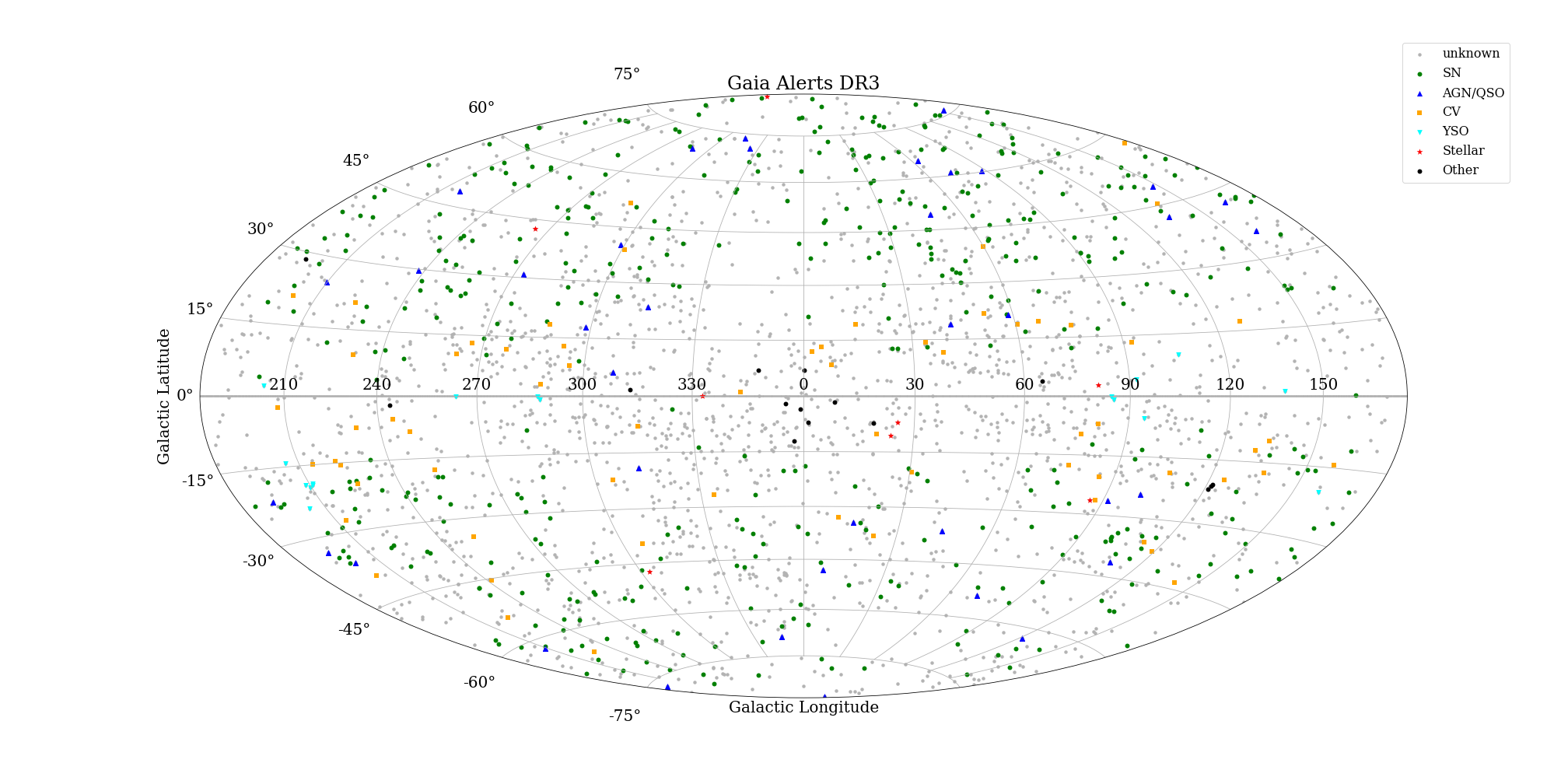Do they go boom? - Gaia
Do they go boom?
Gaia's science alerts
As soon as the scientific data gathered by Gaia has been received on Earth, a software pipeline kicks in to see if there are objects out there going wild. Are they suddenly brightening, or dimming peculiarly? If so, alerts are posted on the Gaia Photometric Science Alerts website to allow astronomers across the world to follow up on such unexpected dimming or brightening of stars and other sources. With Gaia's third data release, a complete table of science alerts is made available from the Gaia Archive.
The table of science alerts covers the period during which data has been gathered for Gaia's data release 3: the 34 months between 25 July 2014 and 28 May 2017. In the sky map below, the alerts that have been raised in this period are shown in galactic coordinates, with colour-coding to highlight the different types of events caught. A total of 2612 science alerts triggered in the period underlying Gaia DR3 are shown in the figure. Gaia turns out to be quite successful at detecting transients and is in the top 5 for reporting transients.
Sky map of the Gaia Photometric Science Alerts included in Gaia Data Release 3, shown in galactic coordinates. The grey points are unclassified transients and the coloured points represent spectroscopically confirmed alerts. Supernovae are plotted as green circles. Active Galactic Nuclei (AGNs) and Quasars are highlighted as blue triangles. Cataclysmic Variables show up as orange squares, and Young Stellar Objects as cyan inverted triangles, and stars as red star symbols. The 'other' category includes small classes like microlensing events, galactic novae and X-ray binaries. Image credit: ESA/Gaia/DPAC - CC BY-SA 3.0 IGO. Acknowledgement: created by Elmé Breedt, University of Cambridge.
Gaia sends an alert also when a regular star gets brighter - this could be a signature of a gravitational microlensing event when a foreground object bends the space-time and magnifies the light of the background star. Such events can be caused either by regular stars, but also by dark objects, like neutron stars or even black holes! Microlensing events were also searched in the Gaia DR3 data from 2014 until 2017 and 363 events were found (Wyrzykowski et al. 2022). The next Gaia Data Release 4 will provide complementary information on the change in position caused by lensing, a very subtle effect detectable only by Gaia in hundreds of microlensing events. Such a full picture of microlensing events will yield black holes and other dark lens discoveries!
Animation of the 363 microlensing events in Gaia's Data Release 3 shown in 30 seconds. Credit: ESA/Gaia/DPAC - CC BY-SA 3.0 IGO. Acknowledgements: Maja Jablonska, Andrzej Krupka, Lukasz Wyrzykowski (University of Warsaw). More details in the story "how do they blink".
Credits: ESA/Gaia/DPAC
Story by: Tineke Roegiers, Elmé Breedt, Lukasz Wyrzykowski
Published: 13 June 2022
- Removed a total of (7) style text-align:center;
- Removed a total of (3) style text-align:justify;
More Gaia DR3 stories?
Where are the stars? How far away are they? How bright are the stars?
What colour do they have? What are the stars made of?
Where do they go? Where do they come from? Do they approach us? Do they move away?
Did something move in front of the star? What is in between the stars?
How big, warm, old, ... are they? How do they Blink?
Is it a double star? Do they go boom? Is it a galaxy?
Is it a solar system object? Is it a quasar?
Who created the data? Can I Use Gaia data with other observatories?
How did DPAC produce the data for this star? Where is the data?
-
ESA's press release of Gaia Data Release 3
-
Gaia's Early Data Release 3 stories
-
ESA's press release of Gaia Early Data Release 3
- Removed a total of (16) style text-align:center;








































 Sign in
Sign in
 Science & Technology
Science & Technology


